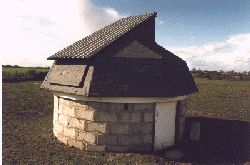



Using CCD's
Piggy Back
Photography
Simple Astro
Photography
Building a DC/AC inverter
Slide Processing
Choosing
Binoculars
Solar Eclipse
Photography
Using DSC's
Portable light
screen
Solar Observation |
|
|

Building an Observatory

Introduction
Having tried (and failed) to build a successful 8 foot diameter dome, I realised
there had to be a better way. Looking for inspiration, I bought the book
"How to Build your own Observatory" Reprints from Telescope Making Magazine,
third edition. published by Kalmbach Publishing, ISBN 0-913135-06-2 . The
observatory shown in the accompanying images is based on the design by Tom
Dey with the exception of a stronger wall made of solid concrete blocks rather
than his plywood one, and corrugated steel sheet rather than translucent
plastic or fibre glass for the roof doors (I'm not convinced about the long
term reliability of plastics and fibre glass). The overall diameter is 12
feet with a roof slot 5 foot wide by 10 long, so there's no need to keep
moving the roof while observing.
All the images are around 15K in size,
click on any for a larger view, return by right clicking the mouse
The actual construction is well covered in the book, so I won't go over common
ground here, except to point out one or two points which will probably give
some concern. Firstly you really do need a decent hand held circular saw,
a 7 inch blade and 1100 Watt motor is the minimum. Screw cutting and welding
facilities are also needed. Access to a surveyors level (that's what you
see on a tripod at construction sites) is useful and enables the wall top
track to be levelled to around 1/8th of an inch relative to any point on
the track.
The concrete block wall is topped with a cement layer which was originally
coated with epoxy resin for the truck wheels to run on, the resin reduced
damage to the cement by the nylon wheels and also kept friction to a minimum.
This change from a plywood wall to a concrete one was considered necessary
both from a climate point of view and also for increased security. The
construction of the roof panels requires good weather or a large shed in
order to pre-assemble them, it helps to build a small balsa wood model and
to number the panels for assembly on site The 'missing' angle of the lower
panel edges is 53 degrees, that's the angle each panel edge needs in order
to give a gap free joint to it's neighbour, no I'm not a genius at mathematics,
just good at trial and error! The panels were treated with preservative then
heavy duty roofing felt glued on with molten pitch. These jobs are best done
prior to final assembly with the panels flat on the ground.
All the images are around 15K in size,
click on any for a larger view, return by right clicking the mouse
Despite it's considerable weight, the roof is reasonably easy to turn, the
eight wheels on their home made suspension units probably help by keeping
all the wheels in contact with the track. The whole assembly is kept from
falling off by four roller bearings running against a plywood ring, there
are also four steel straps to prevent wind lifting the roof off. While it
might not be an ideal solution, holding the roof doors open with 2 x 2 timber
is easy to achieve! The hinges are made water tight with strips of rubber
fish pond liner, the rear of the roof doors have a couple of strips of plywood
that overlap to keep rain from behind entering the observatory. The whole
assembly has stood the wet English weather since 1993 with only a re-painting
of the skirt and door being necessary. In 2004 we gave up with epoxy resin
on the track, having seen floor tiles used successfully at the COAA observatories
we spent a quite modest amount on a few boxes of floor tiles, the whole job
only took around an hour to add the tiles and a further hour to grout them.
Fingers crossed they should provide a relatively wear resistant track for
a few more years.

One of the benefits of having an observatory is not needing to polar align
the mount every time it is used. The observatory is now equipped with a Losmandy
G-11 mount, complete with polar alignment scope. Roughly once a year the
alignment of the mount is checked, just in case someone has kicked the legs
of the tripod. It's so much easier and more comfortable to use an observatory
compared with taking a telescope outside into the dew and wind!
Jump to top of page



|
